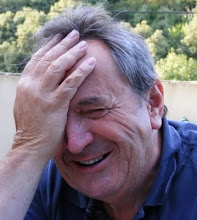This is part of the text of the article which started me thinking again about Art and its place in the World. It's the author Frances Spalding's account of her own joint biography of John and Myfanwy Piper. The article appeared in The Guardian on Saturday 29th August 2009.
"Six months later, in January 1935, the first issue of Axis appeared. Its cover was strikingly modern. Designed by John, it had a bold, uncluttered layout, sans serif lettering and crisp delivery. A quarterly magazine, its contemporary focus caught the attention of Nicolete Gray who, with Myfanwy's help, organised the "Abstract & Concrete" exhibition in 1936, the first truly international display of abstract art in Britain. But shortly afterwards, as Ben Nicholson and Mondrian became ever more purist in their pursuit of abstraction, the Pipers began to waver in their commitment to it. Nicholson and Barbara Hepworth came to Fawley Bottom to straighten them out. They failed. Myfanwy Piper's diary for 13 May 1936 records: "Ben and Barbara. Hell."
"The following year, the Pipers saw Picasso's Guernica at the Exposition Internationale in Paris. Picasso's personality and aggression, Myfanwy recollected, "acted upon us like rape just when we had settled for the Mondrian cloister". John now lost interest in the anonymous, flat surfaces of international modernism. This art had deliberately sought to override national divisions and belonged to no particular country. But with the approach of war and the possibility of invasion, it suddenly mattered very much to which country you belonged. Moreover, the threat of destruction gave England's heritage a new preciousness. With this, Piper found that a sense of place and history were elements he could no longer overlook. From now on, he sought to marry his interest in the modern with his love of tradition. Myfanwy upheld his change of stance. "If art is to have any importance," she wrote, "it must be intimately related to life in its own time."
"And so, in his paintings of ruined abbeys, country houses and bomb-damaged churches, John Piper opened his art to location, belonging, identity and memory, all issues very much to the fore in today's world. He can nowadays be seen as a pivotal figure in the history of 20th-century British art, the artist who licensed the return of much in the human psyche. But in the late 1930s, Nicholson and Hepworth looked on him as a traitor to the modernist cause, faithless to its creed. Herbert Read was another who regarded him as "an apostate". Since then, art historians have sometimes accused him of insularity, of helping to bring about a Romantic revival incompatible with wider and more cosmopolitan values. But, though surprised by the vehemence of the antagonism he had aroused, Piper did not alter his change of focus. To Paul Nash he wrote: "After an abstract period, what a release one feels! The avenue at Stadhampton, or the watercress beds at Ewelme, are seen with such new intensity! But if one abstracts them finally, so that the posts are areas of colour, and the waterfall into the watercress bed becomes like a Ben [Nicholson] relief, then the result can be hung perhaps in Cork Street, but not against one's heart."
"Both Pipers now distrusted ideological straitjackets. Looking at Picasso's cubism, Myfanwy realised its modernity lay not in the shattering of form, but in the need to find a way of dealing with the remaining fragments and remnants of objects. For her, these paintings represented "not a new world but the old world in new and shattered circumstances". And it was here she found art history in the making; not in the idealist embrace of a modernist utopia, but in the negotiations and reconciliations between rooted experience and innovative methods."
I hope I may be forgiven for quoting such a large chunk of Prof Spalding's article - which she wrote as publicity for her book (John Piper, Myfanwy Piper: Lives in Art, by Frances Spalding, is published next month by OUP (£25). I would like to develop my thoughts on the place of Art at the beginning of the 21st Century with the above paragraphs as my starting pint. Watch this space . . . .
Subscribe to:
Post Comments (Atom)

No comments:
Post a Comment